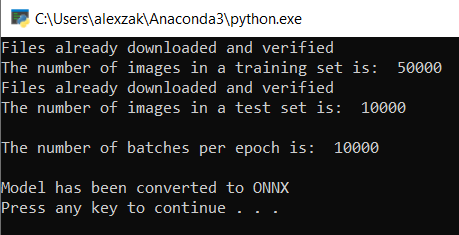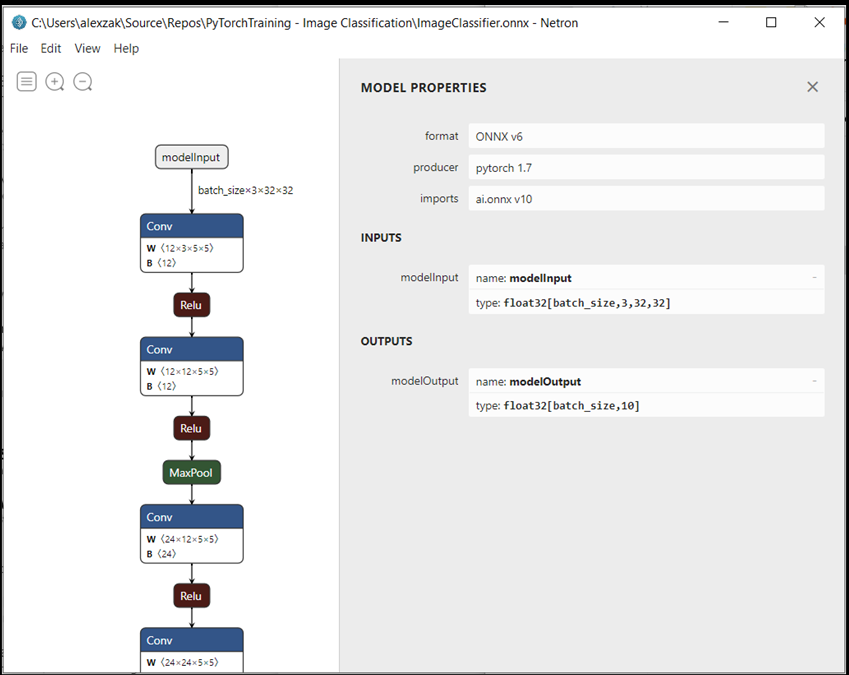将 PyTorch 训练模型转换为 ONNX
备注
为了获得更大的功能, PyTorch 还可用于 Windows 上的 DirectML。
在本教程的上一阶段中,我们使用 PyTorch 创建了机器学习模型。 但是,该模型是一个 .pth 文件。 若要将其与 Windows ML 应用集成,需要将模型转换为 ONNX 格式。
要导出模型,你将使用 torch.onnx.export() 函数。 此函数执行模型,并记录用于计算输出的运算符的跟踪。
- 将 main 函数上方的以下代码复制到 Visual Studio 中的
PyTorchTraining.py文件中。
import torch.onnx
#Function to Convert to ONNX
def Convert_ONNX():
# set the model to inference mode
model.eval()
# Let's create a dummy input tensor
dummy_input = torch.randn(1, input_size, requires_grad=True)
# Export the model
torch.onnx.export(model, # model being run
dummy_input, # model input (or a tuple for multiple inputs)
"ImageClassifier.onnx", # where to save the model
export_params=True, # store the trained parameter weights inside the model file
opset_version=10, # the ONNX version to export the model to
do_constant_folding=True, # whether to execute constant folding for optimization
input_names = ['modelInput'], # the model's input names
output_names = ['modelOutput'], # the model's output names
dynamic_axes={'modelInput' : {0 : 'batch_size'}, # variable length axes
'modelOutput' : {0 : 'batch_size'}})
print(" ")
print('Model has been converted to ONNX')
在导出模型之前必须调用 model.eval() 或 model.train(False),因为这会将模型设置为“推理模式”。 这是必需的,因为 dropout 或 batchnorm 等运算符在推理和训练模式下的行为有所不同。
- 要运行到 ONNX 的转换,请将对转换函数的调用添加到 main 函数。 无需再次训练模型,因此我们将注释掉一些不再需要运行的函数。 main 函数将如下所示。
if __name__ == "__main__":
# Let's build our model
#train(5)
#print('Finished Training')
# Test which classes performed well
#testAccuracy()
# Let's load the model we just created and test the accuracy per label
model = Network()
path = "myFirstModel.pth"
model.load_state_dict(torch.load(path))
# Test with batch of images
#testBatch()
# Test how the classes performed
#testClassess()
# Conversion to ONNX
Convert_ONNX()
- 选择工具栏上的
Start Debugging按钮或按F5再次运行项目。 无需再次训练模型,只需从项目文件夹中加载现有模型即可。
输出将如下所示。

导航到项目位置并找到 .pth 模型旁边的 ONNX 模型。
备注
想要了解更多内容? 查看有关导出模型的 PyTorch 教程。
使用 Netron 打开
ImageClassifier.onnx模型文件。选择数据节点,打开模型属性。

如你所见,该模型需要一个 32 位张量(多维数组)浮点对象作为输入,并返回一个 Tensor 浮点作为输出。 输出数组将包括每个标签的概率。 根据模型的构建方式,标签由 10 个数字表示,每个数字代表 10 个对象类别。
| 标签 0 | 标签 1 | 标签 2 | 标签 3 | 标签 4 | 标签 5 | 标签 6 | 标签 7 | 标签 8 | 标签 9 |
|---|---|---|---|---|---|---|---|---|---|
| 0 | 1 | 2 | 3 | 4 | 5 | 6 | 7 | 8 | 9 |
| 飞机 | car | bird | cat | 鹿 | 狗 | 青蛙 | 马 | 轮船 | 卡车 |
你将需要提取这些值来显示 Windows ML 应用的正确预测。
模型已准备就绪,可供部署。 接下来,主要事件是构建一个 Windows 应用程序并在 Windows 设备上在本地运行它。